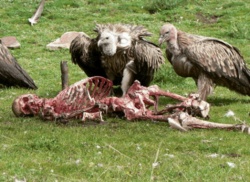Tantric Buddhism; 2
The fourth and final phase of Buddhism entered the world stage in the third century C.E. at the earliest. It is known as Tantrayana, Vajrayana or Mantrayana: the “Tantra Vehicle”, the “Diamond Path” or the “Way of the Magic Formulas”. The teachings of Vajrayana are recorded in the holy writings, known as tantras. These are secret occult doctrines, which — according to legend — had already been composed by Buddha Shakyamuni, but the time was not deemed ripe for them to be revealed to the believers until a thousand years after his death.
It is true that Vajrayana basically adheres to the ideas of Mahayana Buddhism, in particular the doctrine of the emptiness of all appearances and the precept of compassion for all suffering beings, but the tantric temporarily countermands the high moral demands of the “Great Vehicle” with a radical “amoral” behavioral inversion. To achieve enlightenment in this lifetime he seizes upon methods which invert the classic Buddhist values into their direct opposites.
Tantrism designates itself the highest level of the entire edifice of Buddhist teachings and establishes a hierarchical relation to both previous phases of Buddhism, whereby the lowest level is occupied by Hinayana and the middle level by Mahayana. The holy men of the various schools are ranked accordingly. At the base rules the Arhat, then comes the Bodhisattva, and all are reigned over by the Maha Siddha, the tantric Grand Master. All three stages of Buddhism currently exist alongside one another as autonomous religious systems.
In the eighth century C.E., with the support of the Tibetan dynasty of the time, Indian monks introduced Vajrayana into Tibet, and since then it has defined the religion of the “Land of Snows”. Although many elements of the indigenous culture were integrated into the religious milieu of Tantric Buddhism, this was never the case with the basic texts. All of these originated in India. They can be found, together with commentaries upon them, in two canonical collections, the Kanjur (a thirteenth-century translation of the words of Buddha) and the Tanjur (a translation of the doctrinal texts from the fourteenth century). Ritual writings first recorded in Tibet are not considered part of the official canon. (This, however, does not mean that they were not put to practical use.)
